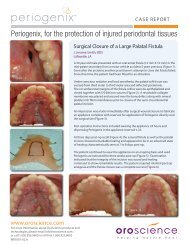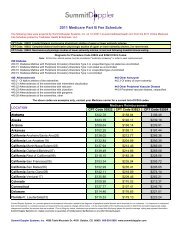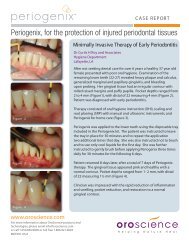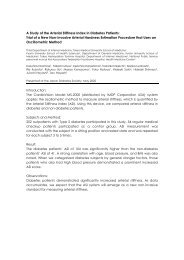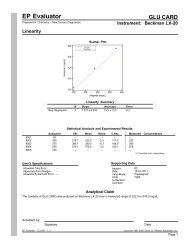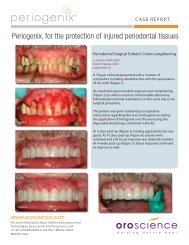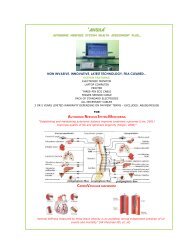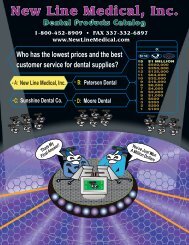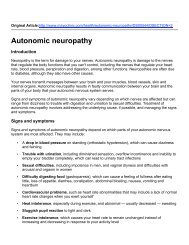White TSH - New Line Medical
White TSH - New Line Medical
White TSH - New Line Medical
Create successful ePaper yourself
Turn your PDF publications into a flip-book with our unique Google optimized e-Paper software.
EP Evaluator<br />
<strong>New</strong> Century Diagnostics, Inc.<br />
Complex Precision<br />
Report Interpretation Guide<br />
The Complex Precision Module is used in three situations:<br />
• A manufacturer wants a statistically rugged procedure<br />
recognized in the industry to determine precision to be<br />
included in official documents for submission to<br />
regulatory bodies.<br />
• A user wants to determine whether an instrument meets<br />
the manufacturer's claim for precision using a<br />
statistically valid approach.<br />
• A user wants to determine both within-run and total<br />
precision.<br />
Experiment Procedure<br />
• Define the number of replicates per run, runs per day,<br />
and number of days for the experiment. CLSI EP5<br />
recommends 2 replicates per run, 1 or 2 runs per day,<br />
for a minimum of 20 days.<br />
• Collect data for a preliminary run of 8-20 results. The<br />
preliminary run is used to detect outliers. This step is<br />
optional, but strongly recommended. (It is required for<br />
EP5 compliance.)<br />
• Collect data for the full duration of the experiment. The<br />
number of replicates per run and runs per day must be<br />
the same for all days.<br />
Definitions<br />
Precision. Ability to obtain the same result upon repeated<br />
measurement of a specimen.<br />
User's Concentration. Grand mean, computed by adding<br />
the results (across all days, replicates, and runs) and<br />
dividing the total by the number of results.<br />
Claim Concentration. Concentration at which the<br />
manufacturer's SD claims were determined. Laboratorians<br />
often think of precision in terms of CV, which is somewhat<br />
constant across concentrations. However, the statistical<br />
calculations in this module are intended to verify SD. Thus<br />
the sample tested should be at approximately the<br />
manufacturer's claim concentration.<br />
Standard Deviation (SD). SD is the primary measure of<br />
Precision (variation of the individual results about the mean).<br />
The point of the Complex Precision experiment is either 1) to<br />
determine whether the SD meets the manufacturer's claim,<br />
or 2) to compute within-run and total SDs to establish such a<br />
claim.<br />
SD Components: The experimental results are analyzed by<br />
a random-effects Analysis of Variance (ANOVA) procedure<br />
to partition the SD into separate components. The two<br />
components usually cited in precision claims are within-run<br />
and total SD. The intent of the following definition of the<br />
components is to be intuitive. NOT to be mathematically<br />
correct.<br />
• Within-run SD. Measures the "average" SD computed<br />
over replicates that occur within the same run<br />
• Between-run SD. SD computed from the means of the<br />
individual runs.<br />
• Between-day SD. SD computed from the means of the<br />
individual days.<br />
• Total SD. Composite of within-run, between-run, and<br />
between-day SD. NOT the answer you would get if you<br />
computed an ordinary SD on all the data, ignoring<br />
replicate number, day number, and run number.<br />
Claim Value (of SD). Two kinds of claims may be verified:<br />
Manufacturer's claims and <strong>Medical</strong> Requirements. A<br />
manufacturer will typically provide separate values for<br />
within-run and total SD. A medical requirement is for Total<br />
SD only.<br />
Verification Value. You can pass the precision test even if<br />
your measured SD is greater than the claim, as long as the<br />
difference is not statistically significant. The Verification<br />
Value is the largest SD that is not significantly different from<br />
the claim. It varies with sample size -- the larger the sample,<br />
the closer the Verification Value is to the claim value.<br />
The precision test passes if the computed SD does not<br />
exceed the Verification Value.<br />
Critical Value. The confidence level on which the<br />
Verification Value is based. Normally the Critical Value is<br />
95%. This means that the Verification Value is equivalent to<br />
a 95% confidence limit -- the observed SD meets the<br />
manufacturer's claim if its lower 95% confidence limit does<br />
not exceed the claim value.<br />
Coefficient of Variation (CV). SD expressed as a percent<br />
of the mean.<br />
Degrees of Freedom (df). df is like an "effective N" for an<br />
SD component. As df gets larger the confidence limit around<br />
the computed SD narrows, and the verification value gets<br />
closer to the claimed value.<br />
Outlier. A result so far from the others as to arouse<br />
suspicion that it was generated by a different mechanism.<br />
Outlier Rejection<br />
The program first calculates the SD of the preliminary run.<br />
This preliminary SD is multiplied by a user-defined Multiplier<br />
(usually 5.5) to compute the Maximum Acceptable<br />
Difference between Replicates. Any run whose range<br />
exceeds this maximum is declared an outlier, and the entire<br />
Printed: 19 Dec 2008 21:37:54<br />
Page 3



